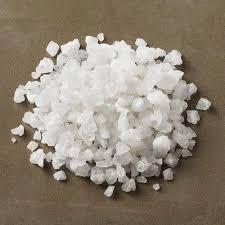Industrial Salt Market Overview Emphasizes Diverse Applications and Global Demand Growth

The industrial salt market plays a vital role in supporting global industries, with applications ranging from chemical processing to de-icing, water treatment, oil & gas drilling, and food production. Unlike common table salt, industrial salt is used in bulk quantities and is critical for a range of industrial processes. With rising demand across developing economies and innovations in extraction and refining technologies, the market continues to expand, offering robust opportunities for producers and stakeholders worldwide.
Market Definition and Scope
Industrial salt, primarily composed of sodium chloride (NaCl), is harvested through methods such as rock mining, solar evaporation, and vacuum evaporation. It is distinguished by its lower purity requirements when compared to edible salt and is widely used for chemical synthesis, infrastructure maintenance, and water management systems.
The market includes multiple forms of salt—rock salt, solar salt, and evaporated salt—each suited to specific applications depending on purity levels, cost-effectiveness, and availability. As global demand for base chemicals and clean water rises, the relevance of industrial salt grows steadily.
Key Market Segments
1. Chemical Industry
The largest consumer of industrial salt is the chemical sector, particularly in the chlor-alkali industry. Industrial salt is a primary raw material in the manufacture of chlorine, caustic soda, and soda ash. These chemicals are in turn used in the production of PVC, paper, glass, soaps, detergents, and other everyday products.
The rapid growth of the construction and automotive sectors, which indirectly drive demand for chemical products, ensures consistent growth in salt consumption. This segment accounts for over half of the global industrial salt usage.
2. De-Icing
In colder regions such as North America and Northern Europe, rock salt is widely used to melt ice and snow on roads and highways. Government procurement programs in snow-prone countries contribute to seasonal spikes in demand.
With increased frequency of extreme weather events due to climate change, de-icing needs are expanding, prompting local governments to enhance storage capacity and streamline procurement logistics.
3. Water Treatment
Industrial salt is a key input in water softening, chlorination, and purification processes. With water scarcity emerging as a global concern, especially in urban and industrial zones, the demand for effective water treatment is growing.
As cities upgrade aging infrastructure and industries adopt more sustainable water management practices, the use of industrial salt in these systems is expected to climb.
4. Oil and Gas Industry
Salt is an essential component in drilling fluids used during oil and gas exploration. It helps control pressure and stabilize boreholes. As exploration activities increase, especially in shale formations and offshore fields, the demand from the energy sector is poised to rise.
Regional Overview
Asia-Pacific
Asia-Pacific dominates the global industrial salt market, with China and India being major contributors. China leads in consumption due to its vast chemical manufacturing base, while India is one of the top exporters, benefiting from large salt flats and favorable climatic conditions for solar salt production.
The region’s rapid industrialization, urban expansion, and infrastructural developments make it the fastest-growing market segment.
North America
North America holds a mature industrial salt market, with consistent demand for de-icing and chemical production. The United States, in particular, maintains a stable consumption pattern, supported by a well-developed oil & gas sector and extensive municipal de-icing operations.
Domestic production is supplemented by imports from countries like Mexico and Chile, especially during high-demand winter months.
Europe
Europe’s market is well-established but undergoing transformation. Environmental regulations are pushing manufacturers to adopt cleaner production techniques. At the same time, the growing use of industrial salt in food processing, pharmaceuticals, and renewable energy storage adds new dimensions to the market.
Market Drivers and Trends
-
Industrial Expansion in Developing Economies: Increasing industrial activities, especially in Asia and Africa, are creating fresh demand for industrial salt in chemical processing and water treatment.
-
Technological Advancements: Modern mining and refining technologies are improving salt purity and operational efficiency, making industrial salt suitable for high-spec applications.
-
Sustainability Focus: Eco-friendly production methods such as solar evaporation are gaining prominence, especially in regions with stringent environmental regulations.
-
Global Trade Dynamics: Countries like India, Australia, and Mexico are becoming major exporters due to their natural advantages and low production costs.
Challenges in the Market
While the outlook is largely positive, the market does face challenges:
-
Environmental Impact: Brine discharge and groundwater salinization from mining operations continue to raise environmental concerns.
-
Seasonality in Demand: De-icing applications lead to fluctuating seasonal demand, requiring efficient storage and logistics planning.
-
Price Volatility: Energy prices and transportation costs can influence salt pricing, particularly in export-heavy markets.
Conclusion
The industrial salt market continues to thrive on the backbone of global industrialization, public infrastructure maintenance, and growing environmental consciousness. With its essential role across multiple industries and geographies, the market offers strong growth potential for producers that can innovate, scale, and adapt to regional and sector-specific demands. From chemical manufacturing to clean water and road safety, industrial salt remains a silent enabler of progress across the globe.
- Art
- Causes
- Crafts
- Dance
- Drinks
- Film
- Fitness
- Food
- Oyunlar
- Gardening
- Health
- Home
- Literature
- Music
- Networking
- Other
- Party
- Religion
- Shopping
- Sports
- Theater
- Wellness


